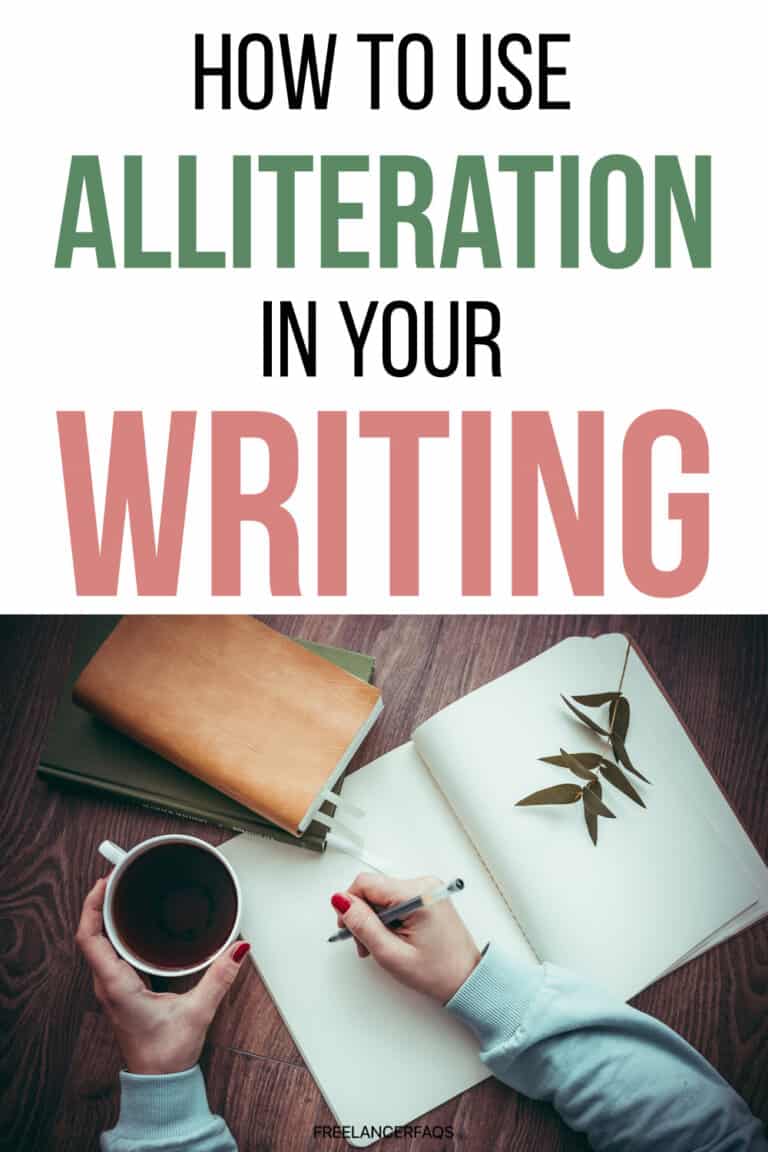There are so many things we are trying to communicate in our writing.
Character development, a plot and story climax, and setting the tone for a piece of literature.

Alliteration is another literary device that brings your writing to a whole new level.
Using alliterations is excellent for creating a mood in your writing that helps to convey to the reader a setting for your story or characters.
While you might have heard of alliterations in writing, it might be unclear what exactly they are or how you can use them in your own writing.
Alliteration Definition
Alliteration is another literary device that brings your writing to a whole new level.
The definition of alliteration is: “the occurrence of the same letter or sound at the beginning of adjacent or closely connected words.”
An alliteration starts with the same letters and sounds and is used for emphasis or to create a certain mood. The important aspect of alliteration is the repetitive consonant sounds.
While repetitive letters can be included, it’s the repetitive sounds that make this literary device an alliteration.
But what does alliteration mean?
Alliterations are found in everyday speech, poetry, prose, children’s books, and novels alike.
The consonant sounds in syllables or two or more neighboring words are repeated.
Often, it is the initial sound that creates alliterations, but not always. There are also alliterations that stress the non-initial letters or sounds.
Some alliterations are much easier to pick up on than others, particularly in more simplified writing like short poems or children’s books.
1. Creating a Mood
Alliterations are great at creating a mood within the writing.
Using more gentle sounds like those with ‘w’ words can help to create a light and softer mood for the overall writing or just a particular part of the story.
When you read something like, “waters wandered,” you think of soft and delicate waters flowing. Perhaps this alliteration goes something like this:
“She stood barefoot in the river as the waters wandered over her.”
On the other hand, when you read something like, “roaring river,” you think of something strong, something much more harsh and forceful. This alliteration might read something like this:
“He held onto the raft as the roaring river nearly capsized him.”
This is achieved not only by using the harsher ‘r’ sound but also through the descriptive words used. You can see the distinct difference in mood and feel with each one of these sentences.
Take this quote from Vladimir Nabokov’s Conclusive Evidence:
“A moist young moon hung above the mist of a neighboring meadow.”
Not only can you visualize this scene, but you can also feel it. You can feel the mist of the night and the dim light from the moon.
It has created a mood for the reader and set the tone for that particular scene.
2. Emphasis
A writer can also use alliteration to emphasize a point or capture the reader’s attention. One common place you see a lot of this is with character names.
Think of Mickey and Minne Mouse and Spongebob Squarepants.
This helps make the main character stand out and memorable. Using an alliteration for emphasis can be more pleasing to the ear (or eye if you’re reading silently).
How to Identify an Alliteration

It’s fairly simple to identify an alliteration.
Read the sentence and say it out loud. Look for words that have the same consonant sound at the beginning. They don’t always have to start with the same letter, but they do have to have the same sound.
For example, the letters ‘g’ and ‘j’ can be used together in an alliteration.
While they are different letters, they can sound the same.
Look at the sentence, “the gentle giant jumped with joy.” Are there two alliterations or just one?
While it might look like two because ‘g’ and ‘j’ are both used, it is actually just one alliteration that is using the same consonant sounds.
Alliteration Examples
There are hundreds of examples of alliterations in everyday speech, content, marketing, poetry, and literature.
3. Pop culture Alliterations
Let’s take a look at some common alliterations that we see in pop culture and in our everyday lives.
- Coca-Cola
- Bed, Bath, and Beyond
- Krispy Kreme
- Dunkin’ Donuts
- Buffalo Wild Wings
- Seattle Seahawks
- Foo Fighters
- Marilyn Monroe
- Beastie Boys
- Peppa Pig
- Peter Parker (Spiderman)
- Jonah Jameson Jr. (The newspaper guy from Spiderman)
- Salazar Slytherin (from Harry Potter)
- The Wicked Witch of the West
- Phineas and Ferb (different letters with the same consonant sound)
So you can see that people that are developing brands, writing comic books, and creating children’s tv shows are all using alliterations.
The late Stan Lee was great at using alliterations in developing his characters.
If you take a look at many Marvel characters, their names are alliterations:
- Dr. Steven Strange
- Bruce Banner
- Peter Parker
- Green Goblin
- Doctor Doom
- Bucky Barnes
- Otto Octavius
And it’s not just Marvel, DC and other famous comic franchises also play with alliterations in naming characters.
- Wonder Woman
- Lex Luthor
- Lois Lane
You get the idea…
Another great example of the use of alliterations is in the movie “V for Vendetta.”
The whole tone of the movie is set by the main character “V” when he perfectly demonstrates the power of verbal alliteration in his introduction to a young woman he saves.
“Voila! In view, a humble vaudevillian veteran cast vicariously as both victim and villain by the vicissitudes of fate, this visage no mere veneer of vanity is a vestige of the vox populi now vacant, vanished, however, this valorous visitation of by-gone vexation stands vivified and has vowed to vanquish these venal and virulent vermin and vanguard and vice vouchsafing and violently vicious and voracious violation of volition. The only verdict is vengeance, a vendetta.”
Considering this is part of the opening scene of the movie it sets the tone that “V” is a brilliant man out for vengeance and is willing to do anything to get it, even memorize this very long alliteration.
4. Alliterations in Everyday Speech
 What are some alliterations that you can think of in everyday speech and language that you might hear on a day-to-day basis?
What are some alliterations that you can think of in everyday speech and language that you might hear on a day-to-day basis?
- I’m tired, I’m going to hit the hay.
- My toddler is busy as a bee.
- Hey boss, quick question…
- My daughter looked picture perfect for her prom.
- He was dead as a doornail.
- We’ll see who gets the last laugh.
- Quit being such a nervous nelly.
There are also many examples of alliteration in famous phrases and quotes.
- Method to the madness
- Pleased as punch
- Right as rain
- Neck and neck
- Out of order
- Home sweet home
5. Alliterations in Poetry
Poetry is another very commonplace alliteration is used.
Think of famous poems like Edgar Allen Poe’s The Raven.
“Once upon a midnight dreary while I pondered weak and weary.”
Another famous line from the opening of William Shakespeare’s Romeo and Juliet is a great example of alliteration:
“From forth the fatal loins of these two foes.”
As you can see, alliteration goes back centuries and is one of the most common literary devices used in history.
There are examples that date all the way back to the very inception of the English language and were first officially identified as being used in the 17th century.
6. Alliterations and Rhyming
Alliterations are also very common in children’s books where there is a lot of rhyming.
There’s no other famous children’s book author that used alliterations as well as Dr. Seuss. Such as “miff-muffered moof,” from The Lorax. Or the “yawning yellow yak.”
Read through any Dr. Suess book and you will be eagerly entertained by all of the alliterations he uses (see what I did there?).
Another well-known children’s author/poet that uses alliterations in their writing is Shel Silverstein.
Take the “Spoiled Brat” poem for example:
The spoiled brat cut a hole in her hat,
The spoiled brat put a coat on the cat,
The spoiled brat got into a spat
‘Bout whether a rodent’s a mouse or a rat.
7. Alliterations in Speeches
Alliterations can also be used in speeches and public speaking to help set the tone for the audience.
An example of this that is used consistently is Martin Luther King Jr.’s I Have a Dream speech.
In his speech, he emphasizes children and uses the hard ‘c’ sound repeatedly.
“I have a dream that my four little children will one day live in a nation where they will not be judged by the color of their skin but by the content of their character.”
8. Tongue Twisters
This is a fun one…
Sally sells sea shells by the sea shore
Peter Piper picked a peck of pickled peppers
How much would a woodchuck chuck if a woodchuck could chuck wood?
FAQs About Alliteration

1. Can C and K be Alliteration?
While C and K are both consonants, they’re not considered to be alliterative because they’re not pronounced in the same way.
Alliteration requires that the two consonants are pronounced identically.
2. What is An Alliterative Name?
An alliterative name is a name where the first and last name begin with the same letter. There are not only names but brands and fictional characters use alliteration in their names.
For example, “Bob Barker” or “Donald Duck.”
3. Do Alliterations Start with Vowels?
Yes, alliterations can start with vowels.
Alliteration is simply the repetition of the same sound at the beginning of multiple words in a row.
The sound can be a consonant, vowel, or even a combination of both. An example of an alliteration starting with a vowel is “Open octagon.”
4. How Many Words Can Be in An Alliteration?
There is no set number of words that can be in an alliteration.
However, it is more common to see shorter alliterations than longer ones.
This is because it can be difficult to sustain the same sound over a long period of time.
5. What’s the Difference Between Alliteration and Assonance?
The main difference between alliteration and assonance is that alliteration is the repetition of the same sound at the beginning of multiple words while assonance is the repetition of the same sound in the middle or end of multiple words.
However, both alliteration and assonance create a rhyming effect in words.
Awesome Alliteration!
As you can see, there are alliterations everywhere.
In the marketing materials that we see in our everyday lives, that we read in books to our kids, and that we hear in movies and on TV.
For more help with your writing, make sure to check out these posts:
- Which Literary Devices Will Make Me a Better Writer?
- When Do You Use a Semicolon? An Easy Way to Remember
- Can You Start a Sentence With Because?
So next time you are writing, try throwing in a few intentional alliterations to create that mood for your audience.




1 Comments